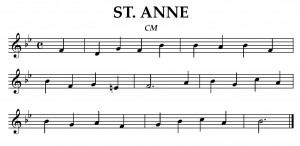Back in 2014, I wrote a list of twenty ways to improvise on a hymn. Many of these are more like exercises than specific ways to create pieces. Following a request for clarification, I thought I’d do a few video lessons to demonstrate the topics.
More and more often I turn to the metaphor of music as a language. When we were young and learning our native tongue, we spent time learning vocabulary lists. Friday was often the day for spelling tests when I was in elementary school. While these exercises may seem simple – the written instructions are often only one or two lines – I believe they are the vocabulary lists for our improvisation studies. When we have chords and keys in our ears and in our hands, we can more easily say what we wish to say when we speak in the language of music.
For these demonstrations, I work with the tune St. Anne, commonly sung with the words “O God, Our Help In Ages Past.” So far, there are a total of three videos that cover the first nine items of the original 20 on the list. Here’s part one:
Because music is so difficult to capture on the written page, I have always found it helpful to have recordings or videos of examples or demonstrations. Especially with the organ, it can be instructive to see how a sound is being created. Is that solo being played by the pedal or the left hand? I remember after listening even to a piano piece by Olivier Messiaen, I had to go buy the score so I could find out how certain sounds were created.
if there are any other past lessons that you would like me to demonstrate, please let me know, and I’ll add them to my to do list.
Livestream
We have recently installed cameras at the Cathedral of Mary Our Queen. In the near future, you should be able to tune in live to hear me play. I am hopeful that I will be able to share more of the pieces I improvise with you when this new camera system is fully functional. Please let me know if you tune in to one of the broadcasts!
Hoping all your improvisations speak to your audience,
Glenn


